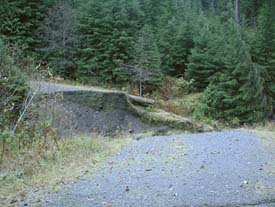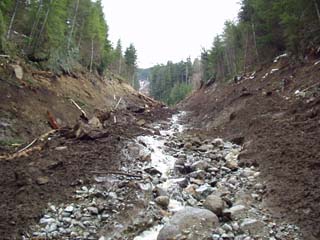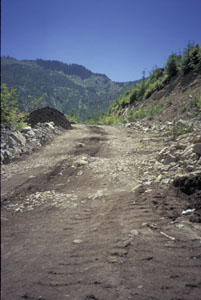
Addressing Road Problems in Olympic National Forest (WA)
|
Over the past few years, many of us who enjoy paddling on the Olympic Peninsula have witnessed the slow but steady degradation of the road network. Now that the peak of logging activity has passed with the removal of much of the timber and new requirements to protect spotted owls, we are left with a road network that has seen very little maintenance over the past decade. Convenient access to the Sitkum was lost, followed by Matheny Creek and Sam’s River, and most recently the Upper Dosewallips. Aside from the lost access, however, the influx of sediment and debris associated with the road failures has resulted in severe degradation of aesthetic qualities of these rivers and their aquatic habitat.
Debris flows are a natural occurrence on our region’s rivers (they are an important source of spawning gravel for instance), but the problem is the high frequency and intensity of these events in areas with poorly engineered roads. If you drive the South Fork Hoh road, there is a section where every single road crossing failed during past winter storms with the result that it looks like someone took an earth mover down to scour out the channel. In some cases this increased sediment can raise the elevation of the river bed with the result that the channel can no longer convey the water it once did. While this is a temporary condition as the river searches for a new equilibrium state, the short-term impact is increased frequency of over-bank flood events. Studies have shown that this is likely occurring in the Skokomish. While the overall discharge of flood events has not increased over time the cross-sectional area of the channel has declined as it has filled in with the increased sediment supply. The result is a river that more regularly overflows its channel. In most cases, all these impacts are most severe 10 to 20 years after intense logging and that’s what we’re seeing on the Olympic Peninsula. Recently, the Olympic National Forest issued a comprehensive Access Travel and Management (ATM) Plan for public comment. This is a significant step in the right direction. Those who value continued access will find that activities already completed or planned will once again return access to the Sitkum and Matheny with roads that are greatly improved and designed to protect aquatic resources. Removal of spur roads and some of the most chronically problematic roads on steep slopes will result in a reduced road network that can be more effectively managed and maintained by the National Forest. The plan represents a fundamental shift in philosophy from a road network designed primarily for quick and efficient timber harvest to a road network that provides public access and protects aquatic resources. Once the initial capital expenditures are made, maintenance costs should also be significantly less. It won’t happen overnight, but creek runs like Matheny will one-day return to their former beauty.
|
Thomas O'Keefe
3537 NE 87th St.
Seattle, WA 98115



